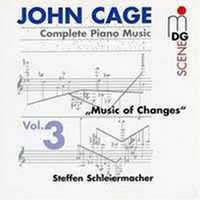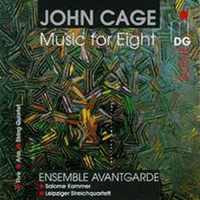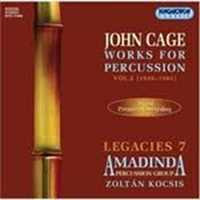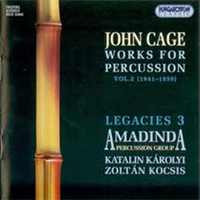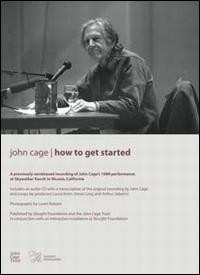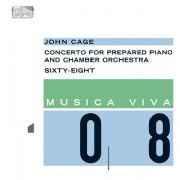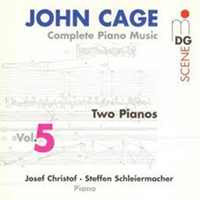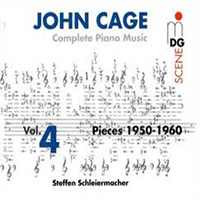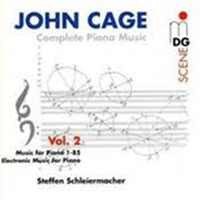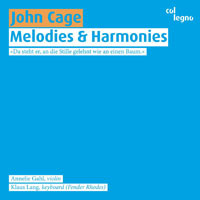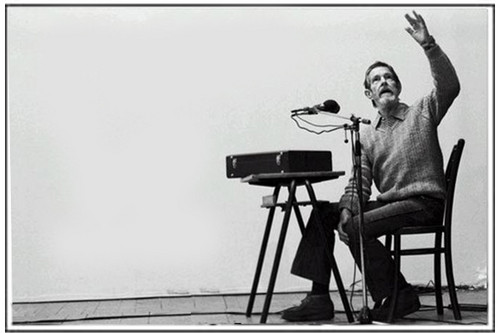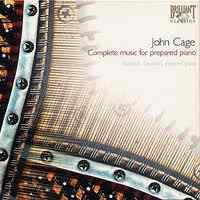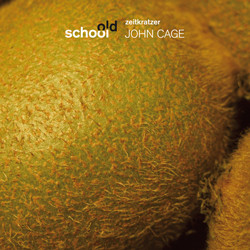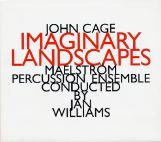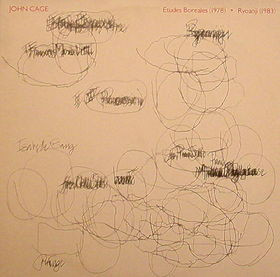JOHN CAGE begins anywhere
"John Cage begins anywhere" is an art exhibition focused on records, photographs, books, videos and visual scores by the legendary composer, held at Die Schachtel (O' art space) in Milano, in july 2011
Complete Piano Music Vol. 3 - Music of changes
“The interpreter is a very important person indeed in Cage’s piano music, and a top international expert like Steffen Schleiermacher is a must for a complete recording such as this one: he knows the nuts and bolts and all the fine nuances.”
Music for eight
Digital recording: August 17-18, 1995 at Fürstliche Reitbahn Arolsen, Germany and October 26, 1995 in Leipzig.Includes 32 page booklet.
Works For Percussion Vol.5
World Premiere Recording: Hungaroton Studio, 2007 Ensemble – Amadinda Percussion GroupPercussion – Aurél Holló, Károly Bojtos, Zoltán Rácz, Zoltán Váczi
Works For Percussion Vol.3-Four4
World Premiere RecordingRecorded at the Hungaroton Studio in March, 2000Score: Henmar Press, Inc., New York (corrected after the autographs and J. Cage's indications)Ensemble – Amadinda Percussion GroupPercussion – Aurél Holló, Károly Bojtos, Zoltán Rácz, Zoltán Váczi
Works For Percussion Vol.2 (1941 - 1950)
Recorded at the Hungaroton Studio in December 1998 and February-March and May 2000Includes a 20-page booklet in English, French, German and HungarianPercussion – Aurél Holló (tracks: 1 to 6, 11, 13), Károly Bojtos (tracks: 1, 3, 4, 8, 9, 11), Zoltán Rácz (tracks: 1 to 4, 6, 8, 9 ,11), Zoltán Váczi (tracks: 1 to 4, 8, 9 ,11)Piano – Zoltán Kocsis (tracks: 2, 7, 10, 12)Piano [Closed Piano] – Aurél Holló (tracks: 5, 13)Voice – Katalin Károlyi (tracks: 5, 6, 12, 13)
How To Get Started
"John Cage conceived How To Get Started almost as an afterthought -- a performance substituting for another that was previously planned in 1989 for delivery at 'Sound Design: An Invitational Conference on the Uses of Sound for Radio Drama, Film, Video, Theater and Music' presented by Bay Area Radio Drama at Sprocket Systems, Skywalker Ranch, in Nicasio, California. In his introduction, Cage talks about the difficulty of initiating the creative process, while exploring the usefulness of im…
Concerto for Prepared Piano and Chamber Orchestra / Sixty-Eight
For each of his compositions for prepared piano Cage created a specific piano preparation chart, setting out in meticulous detail the strings to be prepared, and the materials and manipulations to be used for preparing them. For the Concerto for Prepared Piano and Chamber Orchestra (1951), 53 tones of the keyboard must be prepared; and in this case Cage himself was astonished at the complexity of these preparations. The range of sounds is further expanded by an extra bridge installed in the pian…
Music For Percussion Quartet
As early as in 1942, in Credo in Us, Cage employed not only a percussion ensemble but also sounds from the radio and records. Therefore, quite in accordance with what the composer would have wished, the materials used by the Percussion Ensemble Mainz in this recording range from Beethoven's fifth symphony (vinyl record, including the rustling) to ABBA, Tina Turner and advertising slogans. It goes without saying that rhythms play an important part in music for percussion. Cage, though, was also i…
Complete Piano Music Vol. 6 - Pieces 1960-1992)
Recording: February, 21-24, 2000, Fürstliche Reitbahn Bad Arolsen 28-page booklet includes text in English, French and German “The interpreter is a very important person indeed in Cage’s piano music, and a top international expert like Steffen Schleiermacher is a must for a complete recording such as this one: he knows the nuts and bolts and all the fine nuances.”
Complete Piano Music Vol. 5 - Two pianos
Pianists: Josef Christof and Steffen Schleiermacher “The interpreter is a very important person indeed in Cage’s piano music, and a top international expert like Steffen Schleiermacher is a must for a complete recording such as this one: he knows the nuts and bolts and all the fine nuances.”
Complete Piano Music Vol. 4 - Pieces 1950-1960
“The interpreter is a very important person indeed in Cage’s piano music, and a top international expert like Steffen Schleiermacher is a must for a complete recording such as this one: he knows the nuts and bolts and all the fine nuances.”
Complete Piano Music Vol. 2 - Music For Piano 1-85, Electronic M
Includes 36-page booklet of text & photos (with English/French/German text). “The interpreter is a very important person indeed in Cage’s piano music, and a top international expert like Steffen Schleiermacher is a must for a complete recording such as this one: he knows the nuts and bolts and all the fine nuances.”
Melodies & Harmonies
Cage is by no means a synonym for obligingness. All the more astonished we listen to the melodious and harmonious objects Annelie Gahl and Klaus Lang present on this album. Lang, the trained organist and internationally renowned composer, performs these pieces on a Fender Rhodes for the first time. Gahl, known as a versatile interpreter of both Old and New Music, plays the violin exactly as requested by Cage, without vibrato and with minimum weight on the bow. The musical material dates …
Prove di Empty Words, Milano, Teatro Lirico 1977
A very special Die Schachtel art edition, a fine art print on Baryta FB, Hahnemühle, sized cm. 30 x 40 in edition of 15 copies, numbered and signed by the author. Photo taken during the rehearsal of "Empty Words", a Cage's milestone performance which took place at Teatro Lirico in Milan on December 2nd, 1977. The composer sitting at a small school desk, reading words and phonemes taken from diary of H.D.T. with the help of a small light. Empty Words is a long text derived from the journals of H…
Complete music for prepared piano
Awesome complete prepared piano recordings by Giancarlo Simonacci. The prepared piano, which Cage invented in the early 1940s, was such a brilliant invention that no one would have blamed him for spending the rest of his life writing for it. A lesser composer would have done that; Cage being Cage he spent the best part of a decade creating a sublime body of work for it and then promptly moved directly onto his next preoccupation - indeterminacy - and never wrote for the prepared piano agai…
Four4
Four4 for four percussionists (1991). By Simon Allen, Chris Burn, Lee Patterson, Mark Wastell. A unique realisation of one of Cage's late 'number pieces' by an ensemble of musicians better known for their work as improvisers. The 72-minute piece uses a system of flexible time brackets which were determined randomly according to a computer programme. Each musician chooses a number of sounds and assigns each of them them a number. Every time that number occurs above one of the time brackets, they …
(Old school) John Cage
John Cage’s compositions have been part of zeitkratzer’s repertoire since the very first day. The pieces presented here justify zeitkratzer’s reputation as sound specialists. Avant-garde composer Cage is played in a conservative, precise and sensual way, apart from all philosophical ambitions, and hopefully as seductive as a Schubert quintet! The “Wire Magazine” acclaimed: zeitkratzer convinced us that Cage‘s music can still live with all its complexities, stripped of the debris of its ic…
Etudes Australes
With a score derived from star maps - the "Atlas Australis", a book of maps of stars as they can be seen from Australia - and the "I Ching" (64-choice Old-Chinese chance manual) "Etudes Australes" is a quintessentially Cageian work. Grete Sultan is an active recitalist who has performed music both classic and contemporary around the world. "When I wrote the 'Sonatas and Interludes', it was with Maro Amian in mind", Cage said. "David Tudor was in my mind when I wrote the 'Music of Changes'. Witho…
Imaginary Landscapes
Improvising guitarist Derek Bailey has expressed the belief that «If you’re going to explore uncharted territory, it’s okay to carry a compass, but not a map.» It’s obvious; if you know where you’re going and have plotted the most efficient or scenic course to get there, you may arrive without mishap but deprived of much of the drama, the danger, the unpredictable uniqueness of the journey. In the years following 1950, John Cage walked these paths of musical uncertainty, providing performers wit…
Etudes Boreales • Ryoanji
Very scarce John Cage album released on Mode Records in the early eighties. "This two-record set collects some terrific performances in solo and duo contexts and is also quite a fine welcome mat into the Cage . By comparing different versions of "Etudes Boreales" -- first piano solo, then cello solo, then combined -- much can be gleaned about the way this composer thinks, a endlessly interesting subject in itself. The individual players are virtuosos not only in playing but thinking as well, com…
